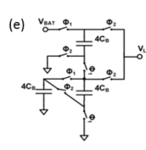DimaKilani
Member level 1
I have multiple transistor of PMOS and NMOS and I want to connect them in a right way .. how can I do that ? for example, if I have two PMOS transistor, the drain of the the 1st transistor should be connected to the drain or source of the 2nd transistor ?
I need to know the proper way of connecting the transistor to eliminate any improper design.
Could you please answer me or provide me with useful links ?
Thanks
I need to know the proper way of connecting the transistor to eliminate any improper design.
Could you please answer me or provide me with useful links ?
Thanks
